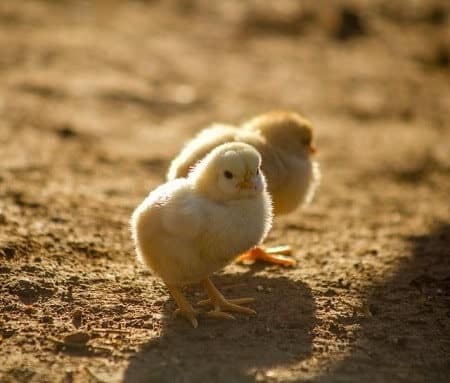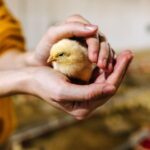If you’re incubating eggs and that magical day when a chick first pokes its egg tooth out is fast approaching - you need to be prepared with food, water, and importantly a warm brooder.
It’s no secret that chicks can’t tolerate the cold very well. Who can blame them? When they first enter the world they don’t even have feathers to keep themselves warm!
Don’t panic though, keeping your chicks nice and warm isn’t difficult. As long as you know the right temperature and have a heat lamp, it’s easy.
Here’s everything you need to know about keeping baby chicks nice and warm:
Table of Contents
How Cold Is Too Cold for Baby Chickens?
When a chick hatches, it’s important that you keep them at a comfortable 95-100 degrees Fahrenheit (or 35-37.8 degrees Celsius) for the first couple of weeks.
The rule of thumb is that you then reduce the temperature in their brooder by 5 degrees each week until they are about a month old.
I don’t know exactly how cold is too cold for baby chickens, because I’ve never let the brooder temp drop lower than the recommended temperature.
Sure, it fluctuates a few degrees throughout the day, and chicks huddling near others will be warmer. But with chicks being so fragile in those first days, and even weeks, you have to keep their temp as close to the recommended heat as possible.
To give you a clearer visual of this, here is a table of the temperature should maintain as they age those first few weeks:
Baby Chick Temperature Chart
| Age of Chick (weeks) | Temperature (F) |
|---|---|
| 0-2 | 100-95 |
| 2-3 | 95-90 |
| 3-4 | 90-85 |
| 4-5 | 85-80 |
I’ve also seen some sites, like Purniamills, recommend tapering off from 1-week old. So, week two would be 95F, week 3 90F, and so on. I’ve discussed this with friends, and this really doesn’t make a big difference.
The important thing is that you use a heat lamp or some other means of warmth to create a warm environment for your new chicks.
Want to know where to buy hatching eggs and chicks online? Check out Cackle Hatchery - this is where I buy all my chicks, hatching eggs, and other poultry.
Related - Are your chicks chirping loudly? Here's what it means.
Do Chicks Need a Heat Lamp?
You don’t have to use a heat lamp to warm up your chick’s brooder. It is the easiest way to maintain an optimal temperature though, in my opinion at least.
As long as you’re maintaining a healthy temperature, you can use whatever methods or heat source you want to.
I’ve heard of chick owners using hot water bottles (literally) by filling plastic milk bottles with warm water. As well as various other containers that are good at retaining heat.
There are also some really good products that provide heat without relying on a lamp. This Brinsea EcoGlow Broody, for example, uses a heated panel that adjusts in height:

They say it improves weight gain and feather growth. I haven’t seen studies to prove that, but it certainly eliminates having a light on around the clock.
When Can Chicks Go Outside?
There are two magical events with hatching and raising chicks; the first is seeing them hatch, and second is seeing them exploring outside for the first time.
Again, I see people with slight differences in opinion on when is the ‘optimal’ time to move chicks outside into a coop.
First of all, they need to have ‘feathered out’, which means they’ve grown proper feathers. Not that chick fuzz they start developing first. For most chickens, this usually means they are at least 6 weeks old.
When they do have their first coat of real feathers, the perfect time is when the low outdoors temperature is around the same as the temperature they are enjoying outdoors.
That makes perfect sense, right? They’ll hardly notice the difference.
Obviously, the weather outdoors means the temperature fluctuates more. They’ll get used to that, and will instinctively find shelter or extra warmth when needed.
Chickens are pretty hardy and good at adapting to different weather conditions. All they need is to be pampered for the first 6-8 weeks of their lives, then they’re generally ready to start figuring stuff out for themselves.
What Else Do Baby Chicks Need?

While we’re on the topic of caring for baby chicks, it’s worth mentioning what else they need in addition to warmth.
Bedding - Bedding is important. This is essentially just shredded material that is safe for chicks, like paper, pine shavings, or straw.
Bedding absorbs droppings and makes it easy to keep their living quarters nice and clean. It also helps retain a little warmth.
Food and Water - Chicks don’t come into the world hungry, they’ve just absorbed the yolk and are usually fine for a day or so.
You should still have some starter feed ready and waiting though. Along with a fresh bowl/waterer of drinking water. Keep both free of debris and make them easy to access.
Apart from these essentials, all you really need to do is make sure they have enough space and good living conditions. It helps to provide a couple of places they get off the ground, too.
A tray of sand is also a nice addition, as chicks bathe in sand. You’ll see them dipping into the sand from an early age and figuring out how it works. It’s amazing really, watching chicks develop in just a few weeks after hatching.
Related - Should you feed your chicks oatmeal?
Resources
Image credits - Photos by Zoe Schaeffer and Karim MANJRA on Unsplash




